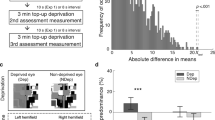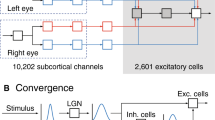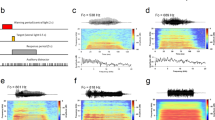Abstract
In the visual cortex of mammals, response properties of single neurons can be changed by restricted visual experience during early postnatal development1. Covering one eye for four to eight hours when kittens are at the peak of the sensitive period is sufficient to weaken the influence of the occluded eye on cortical neurons resulting in a noticeable shift of ocular dominance towards the open eye2–5. The underlying changes in synaptic connections do not occur so readily when a kitten is anaesthetized and paralysed6–8. We report here that an ocular dominance shift is prevented in alert kittens that receive repeated brief monocular exposures when these are followed by ketamine–xylazine anaesthesia. This retrograde effect on cortical plasticity suggests that the process by which synaptic activity is converted into structural changes has been disturbed.
This is a preview of subscription content, access via your institution
Access options
Subscribe to this journal
Receive 51 print issues and online access
$199.00 per year
only $3.90 per issue
Buy this article
- Purchase on Springer Link
- Instant access to full article PDF
Prices may be subject to local taxes which are calculated during checkout
Similar content being viewed by others
References
Wiesel, T. N. Nature 299, 583–592 (1982).
Peck, C. K. & Blakemore, C. Expl Brain Res. 22, 57–68 (1975).
Freeman, R. D. & Olson, C. R. Nature 282, 404–406 (1979).
Freeman, R. D. & Olson, C. R. J. Neurophysiol. 47, 139–150 (1982).
Movshon, J. A. & Duersteler, M. R. J. Neurophysiol. 40, 1255–1265 (1977).
Buisseret, P., Gary-Bobo, E. & Imbert, M. Nature 272, 816–817 (1978).
Freeman, R. D. & Bonds, A. B. Science 206, 1093–1095 (1979).
Singer, W. & Rauschecker, J. P. Expl Brain Res. 47, 223–233 (1982).
Rauschecker, J. P. & Singer, W. J. Physiol., Lond. 310, 215–239 (1981).
Rauschecker, J. P. & Harris, L. R. Expl Brain Res. 50, 69–83 (1983).
Rauschecker, J. P. & Singer, W. Nature 280, 58–60 (1979).
Pettigrew, J. D. & Garey, L. J. Brain Res. 66, 160–164 (1974).
MacDonald, A. & McGrath, J. C. Br. J. Pharmac. 71, 445–458 (1980).
Docherty, J. R. & Starke, K. Br. J. Pharmac. 76, 327–335 (1982).
Thomson, A. M., West, D. C. & Lodge, D. Nature 313, 479–481 (1985).
Lodge, D., & Johnston, G. A. R. Neurosci. Lett. 56, 371–375 (1985).
Anis, N. A., Burton, N. R., Berry, S. C. & Lodge, D. Br. J. Pharmac. 79, 565–575 (1983).
Watkins, J. C., & Evans, R. H. A. Rev. Pharmac. Tox. 21, 165–204 (1981).
Collingridge, G. L., Kehl, S. J. & McLennan, H. J. J. Physiol., Lond. 334, 19–31 (1983).
Harris, E. W., Ganong, A. H. & Cotman, C. W. Brain Res. 323, 132–137 (1984).
Morris, R. G.M., Anderson, E., Lynch, G. S., & Baudry, M. Nature 319, 774–776 (1986).
McGaugh, J. L., & Herz, M. J. Memory Consolidation (Albion, San Francisco 1972).
Squire, L. R. Science 232, 1612–1619 (1986).
Author information
Authors and Affiliations
Rights and permissions
About this article
Cite this article
Rauschecker, J., Hahn, S. Ketamine—xylazine anaesthesia blocks consolidation of ocular dominance changes in kitten visual cortex. Nature 326, 183–185 (1987). https://doi.org/10.1038/326183a0
Received:
Accepted:
Published:
Issue Date:
DOI: https://doi.org/10.1038/326183a0
This article is cited by
-
The 1980s: d-AP5, LTP and a Decade of NMDA Receptor Discoveries
Neurochemical Research (2019)
-
An animal model of hypoxia-induced perinatal seizures
The Italian Journal of Neurological Sciences (1995)
-
The molecular neurobiology of early learning, development, and sensitive periods, with emphasis on the avian brain
Molecular Neurobiology (1993)
-
Glutamate in the mammalian CNS
European Archives of Psychiatry and Clinical Neuroscience (1990)
Comments
By submitting a comment you agree to abide by our Terms and Community Guidelines. If you find something abusive or that does not comply with our terms or guidelines please flag it as inappropriate.



